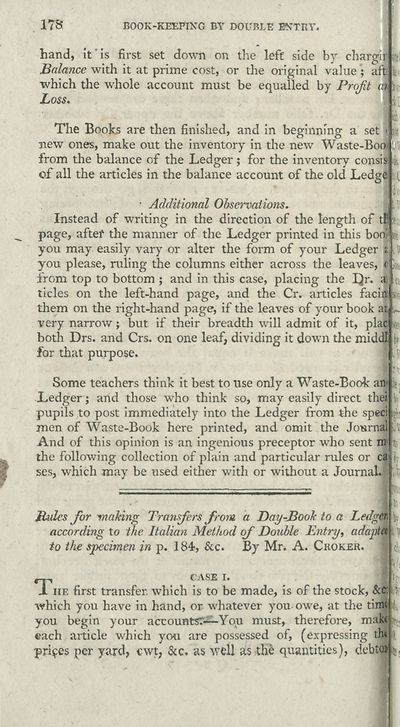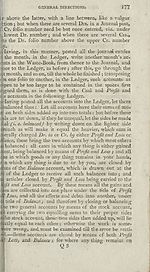Download files
Complete book:
Individual page:
Thumbnail gallery: Grid view | List view

ITS
BOOK-KEEPING BY DOUBLE ENTRY.
hand, it'is first set down on the left side by chargiii]
Balance with it at prime cost, or the original value ; af
which the whole account must be equalled by Profit (
Loss.
The Books are then finished, and in beginning a set 1
new ones, make out the inventory in the new Waste-Bodl
from the balance of the Ledger; for the inventory consij 4
of all the articles in the balance account of the old Ledg<
• Additional Observations. ,
Instead of writing in the direction of the length of d t
page, after the manner of the Ledger printed in this bocj *
you may easily vary or alter the form of your Ledger |, H
you please, ruling the columns either across the leaves, I
from top to bottom ; and in this case, placing the I}r. a-
tides on the left-hand page, and the Cr. articles faci* t
them on the right-hand page, if the leaves of your book at
very narrow; but if their breadth will admit of it, pla™
both Drs. and Crs. on one leaf, dividing it down the midc
for that purpose.
Some teachers think it best to use only a Waste-Book and
Ledger; and those who think so, may easily direct t"
pupils to post immediately into the Ledger from the sj
men of Waste-Book here printed, and omit the Jourr
And of this opinion is an ingenious preceptor who sent fl
the following collection of plain and particular rules or caj
ses, which may be used either with or without a Journal
Bides for 'making Transfers from a Bay-Book to a LedgA
according to the Italian Method of Double Entry, adapt
to the specimen in p. 184, &c. By Mr. A. Croker.
i. ■
he first transfer, which is to be made, is of the stock, &
which you have in hand, or whatever you owe, at the tiil
you begin your acrountsS^-Yqu must, therefore, maf
each article which you are possessed of, (expressing thd
prises per yard, cwt, &c. as well as the quantities), debt
BOOK-KEEPING BY DOUBLE ENTRY.
hand, it'is first set down on the left side by chargiii]
Balance with it at prime cost, or the original value ; af
which the whole account must be equalled by Profit (
Loss.
The Books are then finished, and in beginning a set 1
new ones, make out the inventory in the new Waste-Bodl
from the balance of the Ledger; for the inventory consij 4
of all the articles in the balance account of the old Ledg<
• Additional Observations. ,
Instead of writing in the direction of the length of d t
page, after the manner of the Ledger printed in this bocj *
you may easily vary or alter the form of your Ledger |, H
you please, ruling the columns either across the leaves, I
from top to bottom ; and in this case, placing the I}r. a-
tides on the left-hand page, and the Cr. articles faci* t
them on the right-hand page, if the leaves of your book at
very narrow; but if their breadth will admit of it, pla™
both Drs. and Crs. on one leaf, dividing it down the midc
for that purpose.
Some teachers think it best to use only a Waste-Book and
Ledger; and those who think so, may easily direct t"
pupils to post immediately into the Ledger from the sj
men of Waste-Book here printed, and omit the Jourr
And of this opinion is an ingenious preceptor who sent fl
the following collection of plain and particular rules or caj
ses, which may be used either with or without a Journal
Bides for 'making Transfers from a Bay-Book to a LedgA
according to the Italian Method of Double Entry, adapt
to the specimen in p. 184, &c. By Mr. A. Croker.
i. ■
he first transfer, which is to be made, is of the stock, &
which you have in hand, or whatever you owe, at the tiil
you begin your acrountsS^-Yqu must, therefore, maf
each article which you are possessed of, (expressing thd
prises per yard, cwt, &c. as well as the quantities), debt
Set display mode to:
![]() Universal Viewer |
Universal Viewer | ![]() Mirador |
Large image | Transcription
Mirador |
Large image | Transcription
| Antiquarian books of Scotland > Education > Complete treatise on practical arithmetic and book-keeping > (192) |
|---|
| Permanent URL | https://digital.nls.uk/114435874 |
|---|
| Description | Thousands of printed books from the Antiquarian Books of Scotland collection which dates from 1641 to the 1980s. The collection consists of 14,800 books which were published in Scotland or have a Scottish connection, e.g. through the author, printer or owner. Subjects covered include sport, education, diseases, adventure, occupations, Jacobites, politics and religion. Among the 29 languages represented are English, Gaelic, Italian, French, Russian and Swedish. |
|---|

